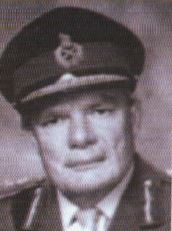John Stanier was born in November 1925 into a talented family that included mathematicians and playwrights. His father died six years later from the aftereffects of a severe head wound in World War One.

An only child, he grew up mainly on farms among knowledgeable adults. In his second year as a scholar at Marlborough, he was cured of a crippling bone defect in both feet that allowed him to live the normal life of a boy. Subsequently, a wartime short course at Oxford gave him an abiding love for classical culture.
A serious attack of diphtheria delayed his commissioning from the RAC OCTU into the 7th Hussars, then stationed in Palmanova in Northern Italy.
He was not long there, however, before the Regiment was moved into tents on the Bassoviza hills overlooking Trieste as part of the concentration against a Yugoslav threat to acquire the whole area of Venezia Julia. It was an idyllic life, interspersed with visits to Trieste itself, including the fine open-air opera in the castle courtyard.
This happy existence came to an end in the autumn when, still a Troop Leader in ‘A’ Squadron, the Regiment moved to the grimmer life in Soltau just south of the Luneberger Heide.
In 1947 the 7th Hussars moved again, this time to Barnard Castle. Soon, however, John was posted back to Trieste to a staff job. He returned to the Regiment in Luneburg as Adjutant in 1951. In 1954 John became an instructor at an Officer Training School at Aldershot for two years before returning again to the Regiment, then in Hong Kong.
In 1957 he attended the Staff College where he wrote and produced the pantomime amid all the other pressures. He was graded A, the only one to achieve this top distinction in his year, and became the MA to the YCGS. For his outstanding work there, he was awarded the MBE.
He came back to the Regiment, now in Munster, to command ‘C’ Squadron. Throughout this time with the Regiment, he, John Venner, and Michael Parker produced many startling Regimental pantomimes and other sometimes somewhat explosive dramatic occasions. In 1964 John was sent as an instructor to the Staff College and promoted to Lieutenant Colonel.
By 1966 five cavalry regiments were due to be commanded by Queen’s Own Hussars and John was badly placed on age for command of his own Regiment. He transferred to command the Royal Scots Greys – no easy task for an outsider – where he earned their respect and did brilliantly. This led subsequently to
command of a brigade, Director of Public Relations, command of a division and then back to the Staff College as Commandant.
From there he went to YCGS where he played a major part in securing the Challenger tank for the British Army and armoured vehicles for the infantry. His last appointment before CGS was as the Commander, UKLF. Throughout these later appointments, he never forgot his parent Regiment and always attended Regimental functions whenever he could.
In 1955 John married Cicely Lambert and they had four daughters and 13 grandchildren. In retirement from active service, John was appointed Constable of HM Tower of London. He hunted with the HH, shot, sailed, and fished the Avon, amidst many voluntary appointments, he was Chairman of the Hampshire Red Cross and became a Deputy Lieutenant of the County.
With his immediate neighbour Miles Hudson, a 9/12th Lancer, he wrote War and the Media. He was also a lecturer on Ultimate Travel tours and The Times frequently published letters by him on a variety of subjects.
He was indeed a Renaissance figure in the range of his interests.
In his painful final illness, he showed remarkable courage, continuing with his friends one of the recreations he had listed in Who’s Who as ‘talking’.


